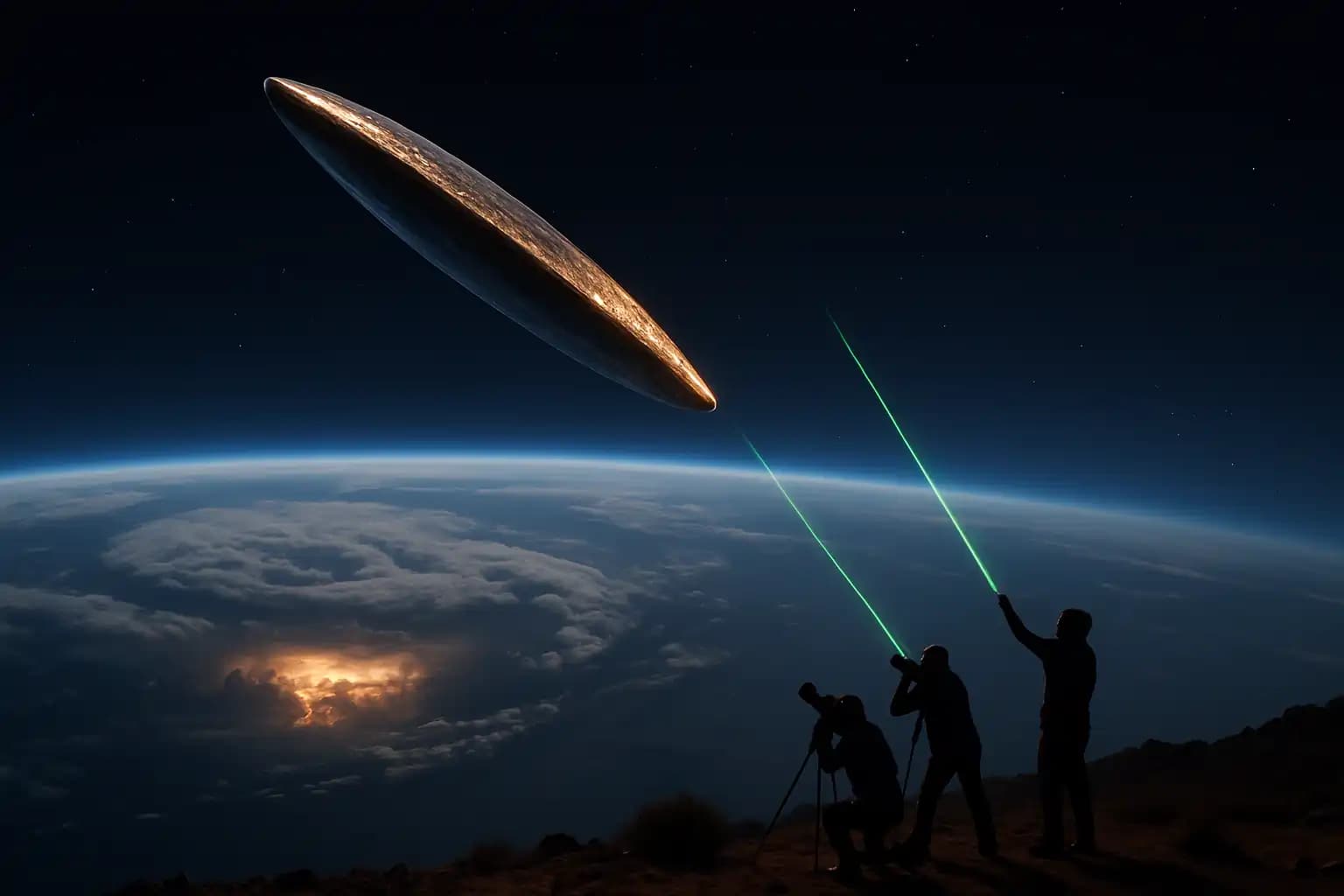1. A Stranger Blows Through the Neighborhood
On 19 October 2017, the Pan-STARRS 1 telescope in Hawai‘i flagged a speck moving at 87 kilometers per second. Initial orbital models stated, “No way this thing was born here.” The trajectory was hyperbolic—open, outbound, never looping back. We named it ʻOumuamua, Hawaiian for “scout” or “messenger.” Poetic: a visitor waves once, never slowing, then bolts for the void like it forgot to turn the stove off.
Slip on your tinfoil hat and note the timing. That same year, scientists recorded gravitational waves, AI investors promised techno-utopia, and global politics spiraled like coffee down a drain. Into this mess sails an interstellar rock with an attitude. Coincidence? I pour another cup of bunker-grade espresso and doubt it.
2. Shape-Shifter in the Dark
Telescopes caught ʻOumuamua only after it passed perihelion, missing the close approach. Photometry revealed wild brightness swings—tenfold every eight hours—suggesting a pancake or cigar shape spinning like a drill bit. If you enjoy academic deep dives, the basic facts hide in ʻOumuamua’s Wikipedia file. They read tame until you see the numbers: a thickness-to-length ratio rivaling a razor blade, and non-gravitational acceleration that ignores Newton.
Ice sublimation should explain the speed bump, yet no dust coma appeared. Some labs proposed hydrogen ice—evaporates invisibly, no fuss. Others laughed because hydrogen ice cannot survive interstellar UV for long. Meanwhile, radio astronomers pointed dishes and heard cosmic silence, but remember: absence of evidence is not evidence of absence—especially when the target silenced itself on purpose.
3. Alien Lightsail or Cosmic Fluke?
Avi Loeb, Harvard’s resident grenade thrower, suggested ʻOumuamua might be a thin lightsail left by long-dead engineers. Mainstream peers called that “sensational,” academic code for heretical. Personally, I find the idea delightful. If ancient aliens wanted to declutter their attic, they might eject obsolete probes. Some would zip past unlucky star systems like ours, broadcasting nothing yet whispering everything.
For skeptics, a natural fragment of a Pluto-style planet works too—rich in nitrogen ice, shattered by tidal forces, planed flat, then baked glossy so telescopes cannot see outgassing. Sure. Possible. So is my lotto ticket. To weigh options, browse fresh pre-prints via this Brave Search, then decide which fairy tale feels less insane.
4. Trajectory Breadcrumbs and the Solar-System Trap
ʻOumuamua entered from roughly the direction of the Lyra constellation—the same patch where scientists search for Dyson spheres because many Sun-like stars huddle there. It left toward Pegasus. Its path skimmed inside Mercury’s orbit, meaning our star accelerated the object. If it were a probe seeking a gravity assist, it executed a textbook slingshot.
This precision thrills fans of autonomous‐navigation lore. An AI starship might chart courses to harvest photons—exactly what we witnessed. NASA claims coincidence, yet the agency admits we spot only a sliver of the sky. How many scouts missed our net? News flash: you secure your windows only after the first burglar strolls through.
5. Impact Odds and Existential Math
Was ʻOumuamua dangerous? Its closest approach to Earth was 0.16 AU—40 lunar distances. Harmless this time, but statistics are harsher. Detection pipeline upgrades now reveal a handful of interstellar objects per decade. Extrapolate volume, and our solar system might host one random wanderer each year. Toss enough dice and you roll snake eyes—a 100-meter interstellar bullet aimed at an unlucky zip code.
If that projectile carried exotic isotopes or microbe hitchhikers, we could wake up in a scenario fit for haunted-ship folklore: oceans glowing, crops wilting, talking heads assuring everything’s fine. Doomsday? Possibly. But hey, cheaper than Netflix.
6. Future Intercepts: Project Lyra and Other Hail-Marys
Enter aerospace dreamers who refuse to watch history speed away. Project Lyra proposes launching a solar-sail craft to chase ʻOumuamua before 2050. The plan relies on a Jupiter fly-by and solar Oberth burn—buzz the Sun so close the sail sizzles, then catapult outward at 70 km/s. White-knuckle engineering? Absolutely. Funding? Vapor for now. You can scan evolving mission architectures through this query.
Why chase? Because direct sampling beats telescope whispers. A close pass could sniff isotopic ratios, photograph surface plating, or even land a chip. If the object removes its cloak and reveals bolts or hieroglyphs, humanity’s self-image exits stage left. If it’s mundane rock, at least we calibrate our paranoia.
7. Cosmic Context: We Live in a Shooting Gallery
Every doomsday-prepper worth his iodine tablets knows space is not empty; it’s an arcade of debris. In 2022, astronomers cataloged a rogue planet with no star. In another corner, a neutron-star collision flung gold dust across light-years, some of which ultimately rains on us. The cosmic stress index, graphed neatly by astronomical risk trackers, trends upward. ʻOumuamua is a postcard from that dangerous neighborhood.
If civilization keeps heads buried in app updates, the next visitor could arrive bigger, hotter, and on collision course. For a diffraction of that vibe, remember Chelyabinsk 2013: a 20-meter rock, unannounced, detonated with 30 Hiroshimas worth of energy. Now imagine something ten times larger and twice as fast. Interstellar objects are faster.
8. Wild Hypotheses—Because Why Stop Now?
1. Solar Sail Debris Field. ʻOumuamua might be a shard of thin metallic foil torn from a megastructure under construction. If stellar civilizations recycle sails, fragments could drift for eons. They would naturally accelerate under radiation pressure—explaining the odd push.
2. Messenger Probe. Some argue the object tried to communicate by changing spin rate in Morse-like bursts. Data noise, say the sober. But telemetry anomalies do exist.
3. Doomsday Seeding. Maybe advanced species lob bio-genetic packages into fertile systems. Hit a planet, catalyze evolution, wait a million years, then harvest resources. Sounds absurd—until you view Earth’s fossil record with its sudden leaps.
9. Practical Steps Before the Next Scout Arrives
Upgrade Surveys. Pan-STARRS 2 and the upcoming Vera Rubin Observatory will widen our radar. We must train AI to flag abnormal trajectories, not just potential impactors.
Build Rapid-Response Propulsion. Nuclear thermal tugs, solar sails, and mass-driver launch loops could hurl probes within months, not decades. Because you cannot interrogate what has already left the building.
Plan Civil Defense. If intercept fails and an object targets Earth, evacuation protocols must exist beyond dusty binders. Urban drills and early-warning sirens—tools explored in geocrisis manuals—should cover extraterrestrial risks too.
10. Closing Arguments from the Bunker Studio
We witnessed our first confirmed interstellar visitor, and mainstream reaction toggled between mild curiosity and polite shrugs. Meanwhile, deep-space rocks keep their poker faces, and telescopes blink. Whether ʻOumuamua was a cosmic accident or a breadcrumb from an ancient map, it shattered complacency. The universe is not a silent backdrop; it is alive with projectiles, and sometimes they stop by without calling first.
If you want to snooze again, fine. My fallout shelter still has room for an extra cot—rent payable in shelf-stable chili. But if you prefer daylight to bunker bulbs, stay curious, fund the survey arrays, and bookmark independent sources like Unexplained.co. The next messenger might not zoom away; it might park nearby, and history shows uninvited guests rarely bring cupcakes.




